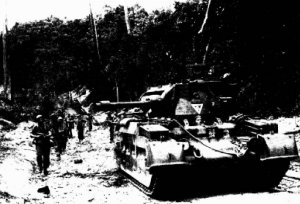Then mainland Brunei
Previous -
Index -
Next
Off the mainland of Brunei Brig Windeyer’s plan for the AIF 20BG was to make a simultaneous landing with the 2/17Btn, in the infantry landing ship (LSI) HMAS Kanimbla, to assault Green Beach embracing Brunei Bluff to Bukrit Cove. And the 2/15Btn in LVT’s to land on White Beach to secure Cape Sapo on Muara Island with one troop of artillery attached to the main assault wave from the 2/8FldRgt. The brigadier also had the LSM (Landing Ship Motor) with a troop of tanks aboard moved to the amphibious assault area offshore for reserve. On another beach the surf would not allow the use of LVT’s, thus precluding the use of 25pdrs so it was decided to land a troop of 75mm pack howitzers by floating the artillery pieces ashore in waterproof packages. Once ashore and assembled the guns had to be manhandled into temporary location and later when a troop of tanks landed they helped to haul the guns into selected gun sites. The mainland area at Brooketon is sandy and flat, add a few casuarina trees with some clumps of rainforest intermingled with the jungle but to the west are steep slopes covered in jungle vegetation, between these hills is cultivated land including coconut trees and rubber plantations.

There are many numerous villages and few towns of any size and importance except Brunei, the capital of the State and Seat of the Sultan. The Allied naval vessels opened up the bombardment at 8.15am on the 10 June, Z-Day, but when the 2/17Btn beached there was no opposition, and at 9.15am sharp on the swampy Muara isle the 2/15Btn searched until dusk and found no Japanese defenders at all. Back on the mainland the Matildas of the 2/9AR had landed and the advance continued meeting little, and or no, organised defensive enemy positions. So by a sunset coloured sky at dusk the Australians were well on the road to Brunei airfield plus the 2/13Btn was put ashore at Green beach moving up to reserve behind the main body in the Foochow-Derby area. The next day a troop of 25pdrs were landed and by noon were in action as the 2/17Btn with two platoons of 2/2MGBtn and a troop of Matildas moved rapidly proceeding south down the road through a defile three miles long between wooded hills and a swamp. An excellent defensive position, yet was not occupied by the enemy and here the troop of tanks halted by a stream being too heavy for the culverts and were left behind. At this stage although the opposition had been light there could be no certainty by viewing the other side of the hill that the dogged Japanese were not preparing a counter-attack, nor the possibility of harassing night infiltration sorties. With aircraft overhead strafing and bombing the small parties of the Japanese garrison encountered, the Australian infantry swiftly advanced astride the road and occupied Brunei airfield then upon entering Brunei town on the evening of the 13 June seven brave Japanese soldiers were shot down in a hopeless banzai charge.
On the shrapnel scared wooden flagstaff near the main jetty the Australians put up the Union Jack and later a captured Japanese officer of the 366 Battalion reckons that the non-stop Allied air-strikes had broken the morale of the garrison, which was resolved to defend Brunei to the last. Fighter defence for the operations area was provided by Thirteenth US Army Air Force Lightnings flown from Palawan and once these aircraft were relieved they strafed specific targets on their departure route. A coastal operation by the 2/13Btn, and two companies 2/15Btn, were landed at Lutong to outflank the enemy retreating from Brunei and happened to recaptured some military vehicles that bore the emu & boomerang ensignia of the ill-fated AIF Eighth Division in Malaya ‘42. The AIF 9 Division, less one brigade at Tarakan, had within a few weeks of landing secured all its objectives against light opposition, and controlled over 180 miles of coast stretching from Miri in the south to Paper in the north, including the valuable yet wrecked oilfields. At the cessation of hostilities the Australians had entered into a phase of extensive patrol activity in all sectors.
Previous -
Index -
Next
|

